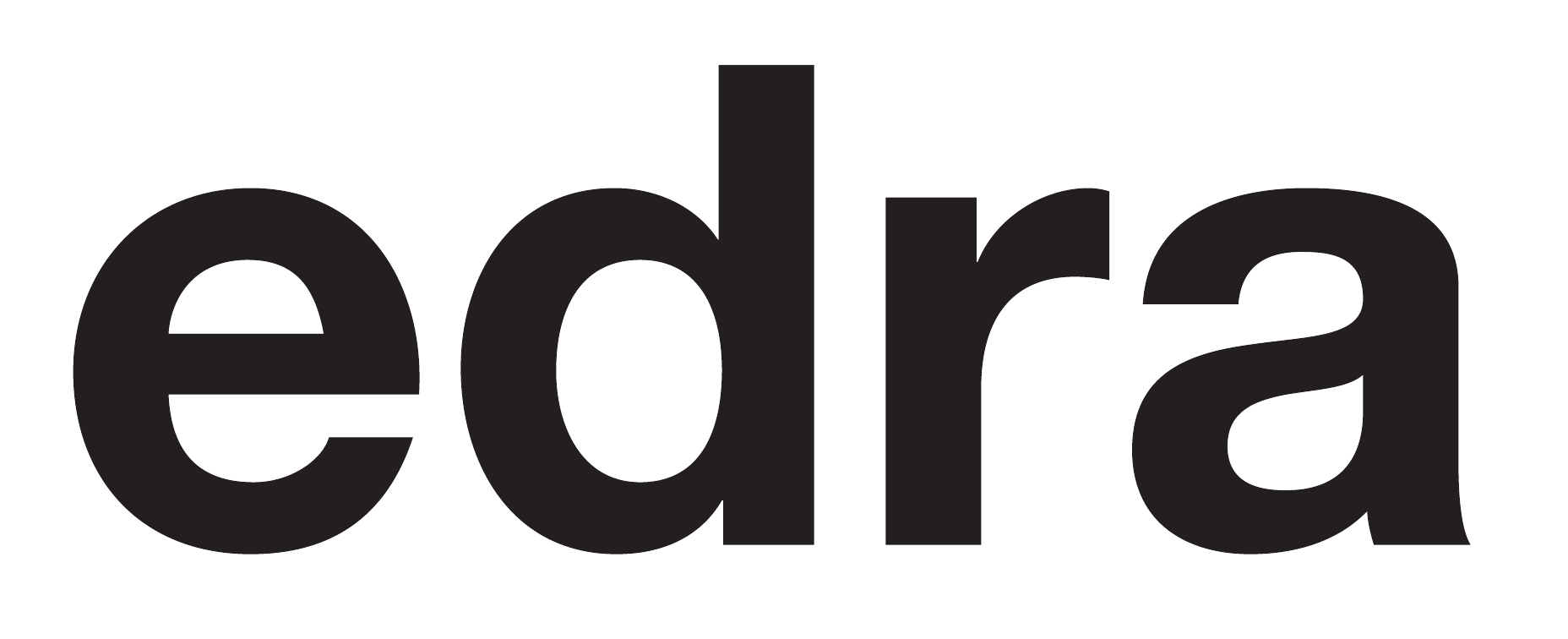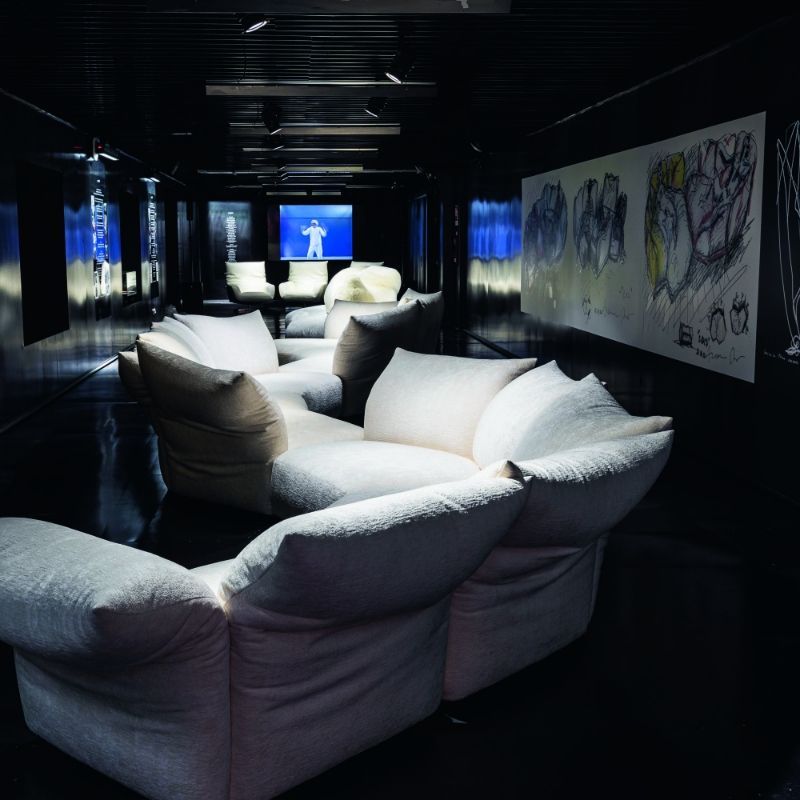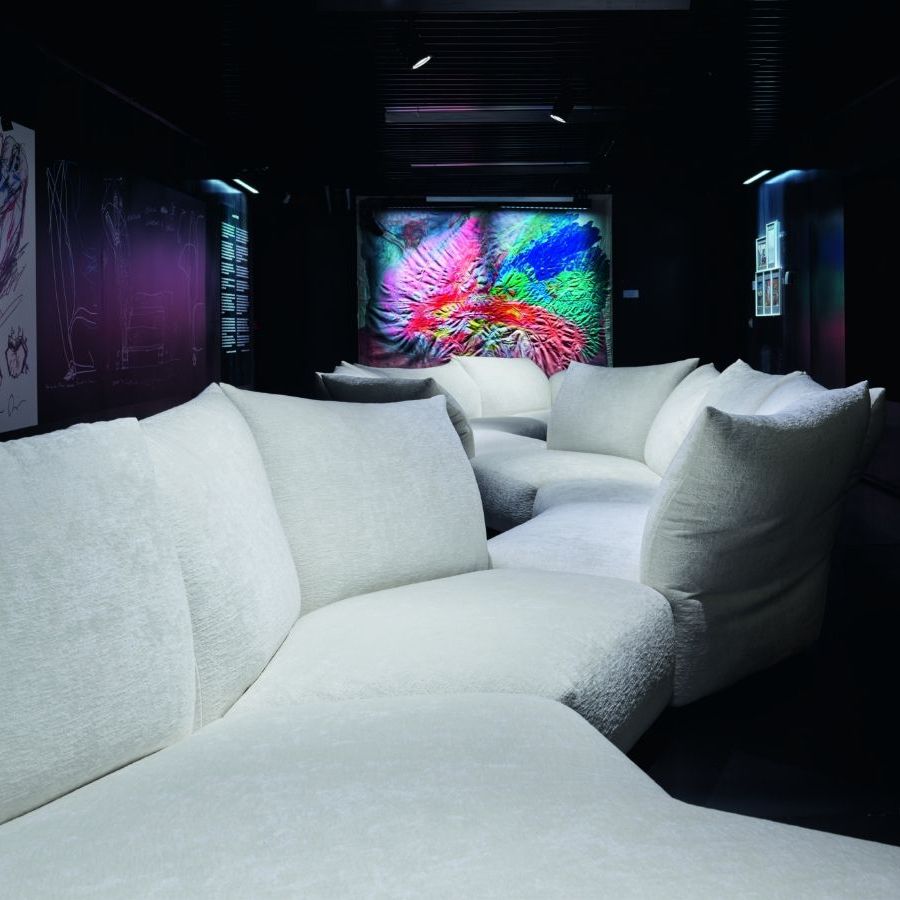
The installation created by Francesco Binfaré as part of the exhibition using “Angelo”, “Colombo” and “Survivors”, with “Mare” carpet from the Edra private collection.
September 2024
L’attimo prima (The moment before)
Exhibition of work by Francesco Binfaré curated by Silvana Annicchiarico at the ADI Design Museum
There is this terrible and fascinating word: design. A word to be reckoned with: we need to understand what it is we are talking about when we discuss it. ADI, the house of design, is based in Milan, and from 15 April to 5 May it hosted an exhibition of work by Francesco Binfaré with the title L’attimo prima (The moment before). It was an art exhibition, with the aim of sharing experience, and perhaps it also had an educational aim, of showing the journey ideas take on their way to gradually becoming concrete objects. Binfaré explains, “The exhibition was an insight into my creative journey, my life journey. Everything was communicated clearly but our aim wasn't to make things understandable in the way a documentary does. I believe it was an exhibition that left a music behind it, and emotions, stimulating intuitions and flashes of understanding on a way of creating. I think we were able to transfer something defined as my fantasies."
The exhibition was curated by Silvana Annicchiarico, who writes, “Francesco Binfaré is a traveller. Other designers might be more similar to gatherers of visions. Instead he is an explorer, a pioneer. Binfaré conceives each adventure in design as a journey, as the tension towards, immersion in a space that is other". We were speaking of education. There is the story of how Flap was born, dreamt of one night as a black rain covering everything except one red space. The shape of that space became the form of Flap. Of course, the work then consists in transforming all this into a sofa, with a structure, and upholstery, and all the rest. Luciano Galimberti, President of ADI, says: “This exhibition offers unique clues into how Francesco Binfaré's world, and his approach, can help us all in our reflection on projects, on life, without any reference to ideology”. At this point there is a line-up to introduce. On display in the exhibition were the sofas produced with Edra - On the Rocks, Pack, Standard, Flap and more. Monica Mazzei, Edra's Vice-president recounts, “Francesco has always come to us proposing models that are first and foremost stories, the first of which was l'Homme et la Femme. In this exhibition there is Francesco's soul, his thoughts and ideas. There is a poetics." The sofas were on display as if to say, this could be the arrival point, but not only sofas. Binfaré's stories were here too. L’Isola (The Island) for example, a series of sketches and drawings, hung one after the other in a sort of serialised story. In the words of the exhibition introduction, these "sequences define a sort of embryonic screenplay, anticipating the seeds of possible future projects”. There was also a painting on a large sheet, one of a number Binfaré exhibited in 1996, thanks to Pierre Restany. “I called it La mia mano destra (My Right Hand), from a series with the title Tracce emozionali domestiche (Traces of Domestic Emotions). I was at a turning point. It was a time when I was leaving my role as artistic and research director in various companies, and moving into a dimension of greater freedom." Running along a corridor was a display case called I miei tormenti (My torments), and a jotter with notes, lists of projects with the Binfaré imprint, from Maralunga to Kar-a-sutra, Aeo and versions of Up. Lines of writing in small letters, full of names, but to see how the notes continue we need to turn the page.
In the words of the introduction, “L’attimo prima is not only an account of Binfaré's way of working, but of how his imaginary has formed and layered over the years. Binfaré's way of working is the result of tireless research activity that began in the Sixties, informed by his relationships and exchanges with other masters such as Gaetano Pesce, Carlo Scarpa, Vico Magistretti and Mario Bellini".
Then there was the terracotta Angelo (Angel), "tutelary deity and guiding spirit of the exhibition" as curator Silvana Annichiarico defines it. Binfaré explains, "the Angel doesn't give answers, it interrogates, but it was the fulcrum of the exhibition.”
The exhibition opened with a video of Giovanni Gastel interviewing Binfaré, and ended with a second video of Binfaré directed by Giuseppe Carrieri, which could have been puzzling but wasn't. In the film Binfaré, dressed in white cotton garments, moves to the notes of Vivaldi's Inverno, interpreting the 'Seed' dance, a Biodanza System exercise evoking the process of creation as the generation of fruits. It expresses the poetics of human encounter based on the experience of being alive, here and now, intensely: in the moment (before).
So where was design? Design was here too, hidden where no one could see it. Observing everything. Taking nourishment. Taking inspiration.
 |
Giampaolo Grassi Parliamentary reporter for the Italian Press Agency Ansa. Before taking an interest in politics, he was in charge of legal news in Florence and fi nancial news in Milan. |










